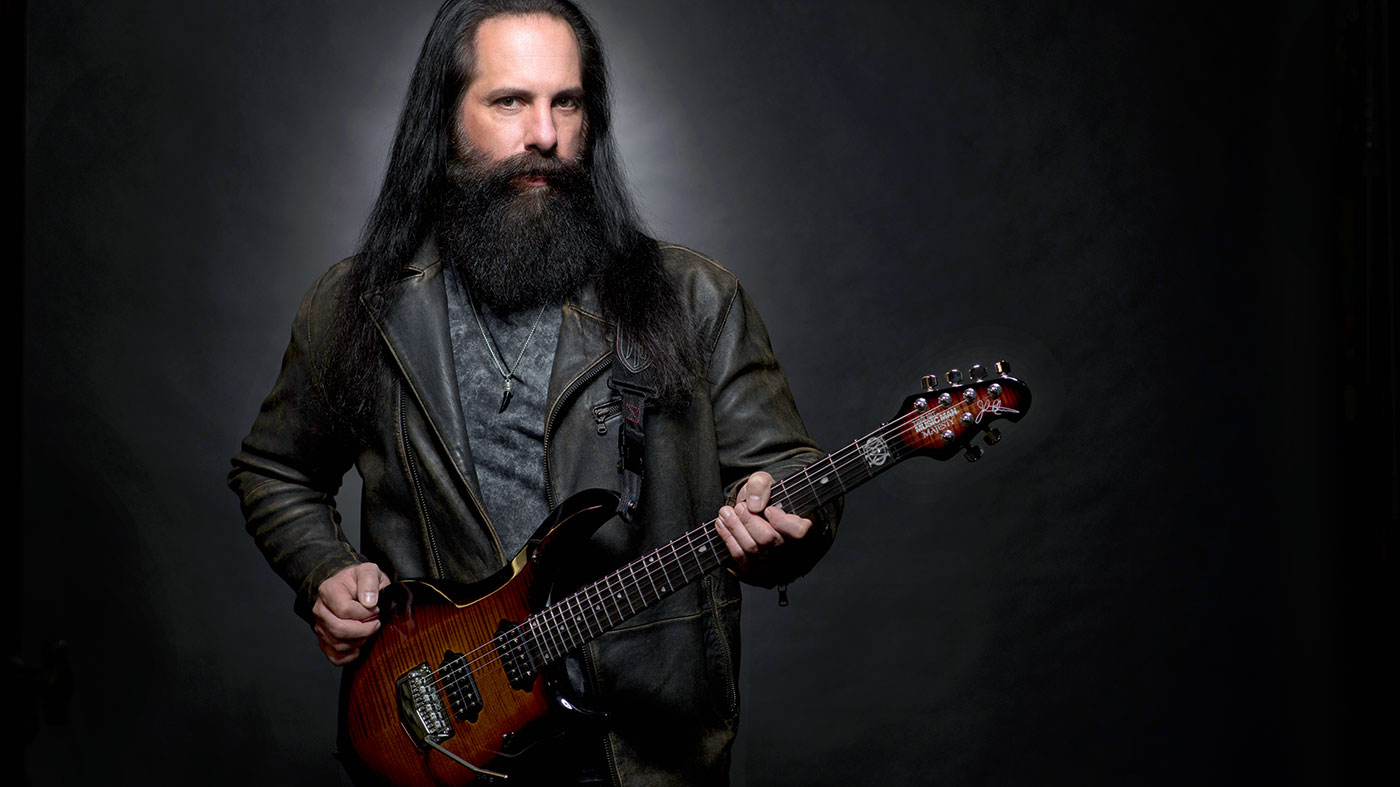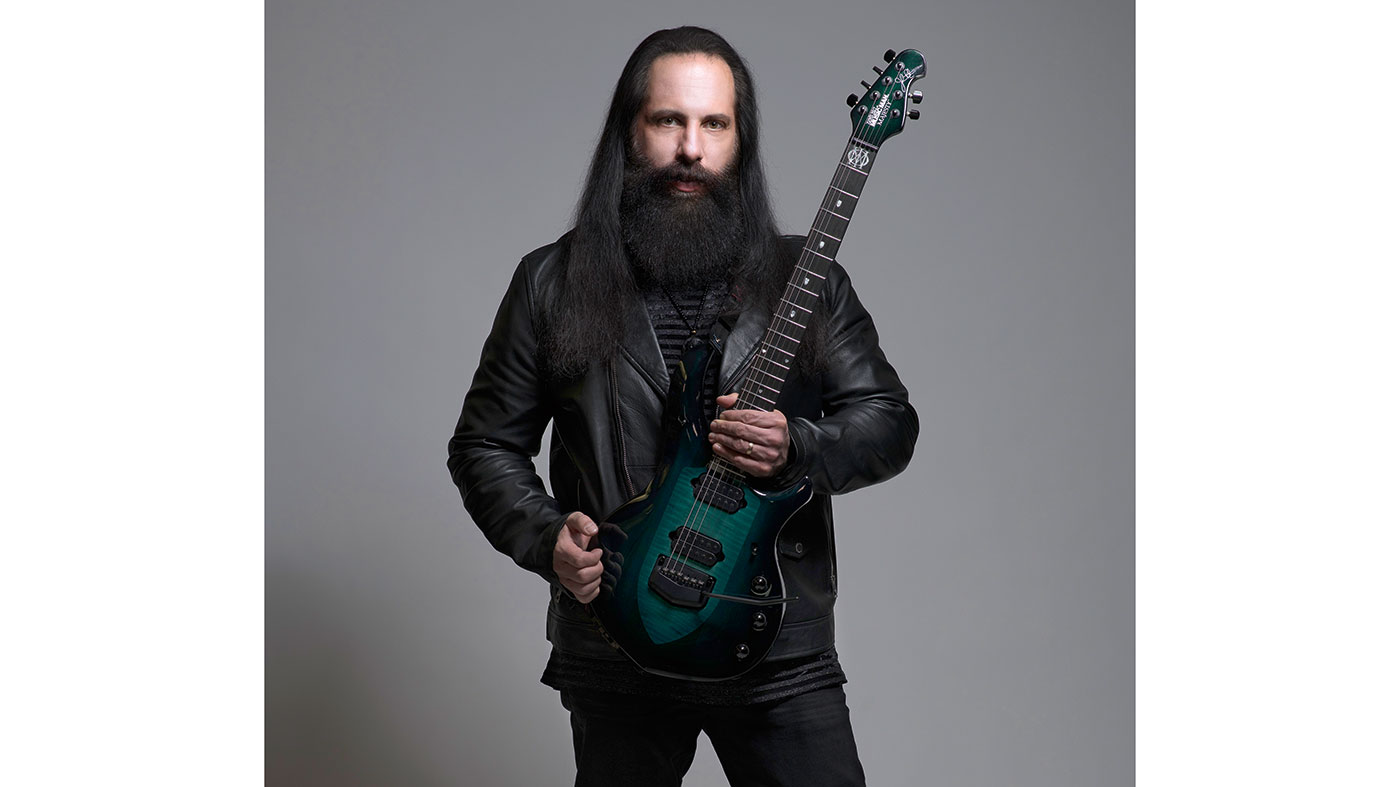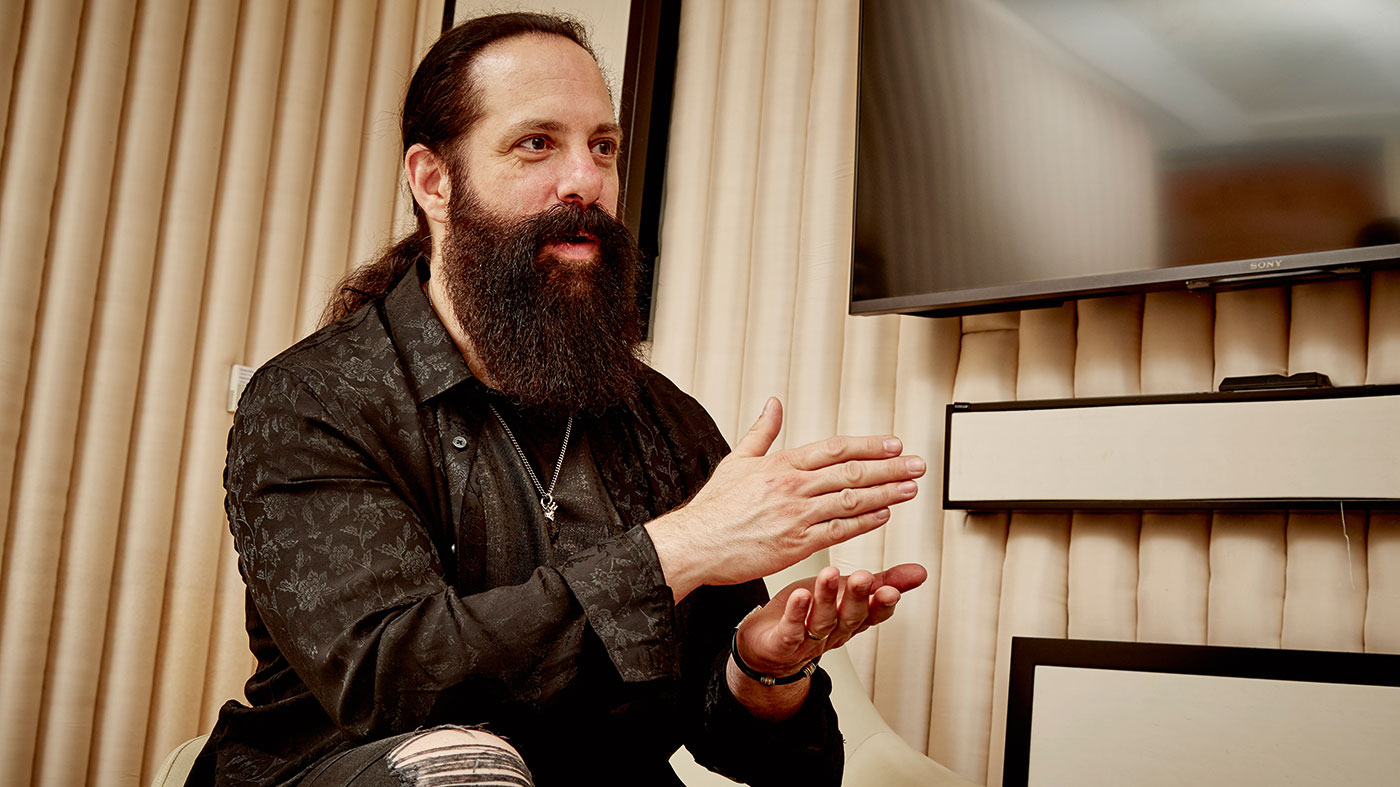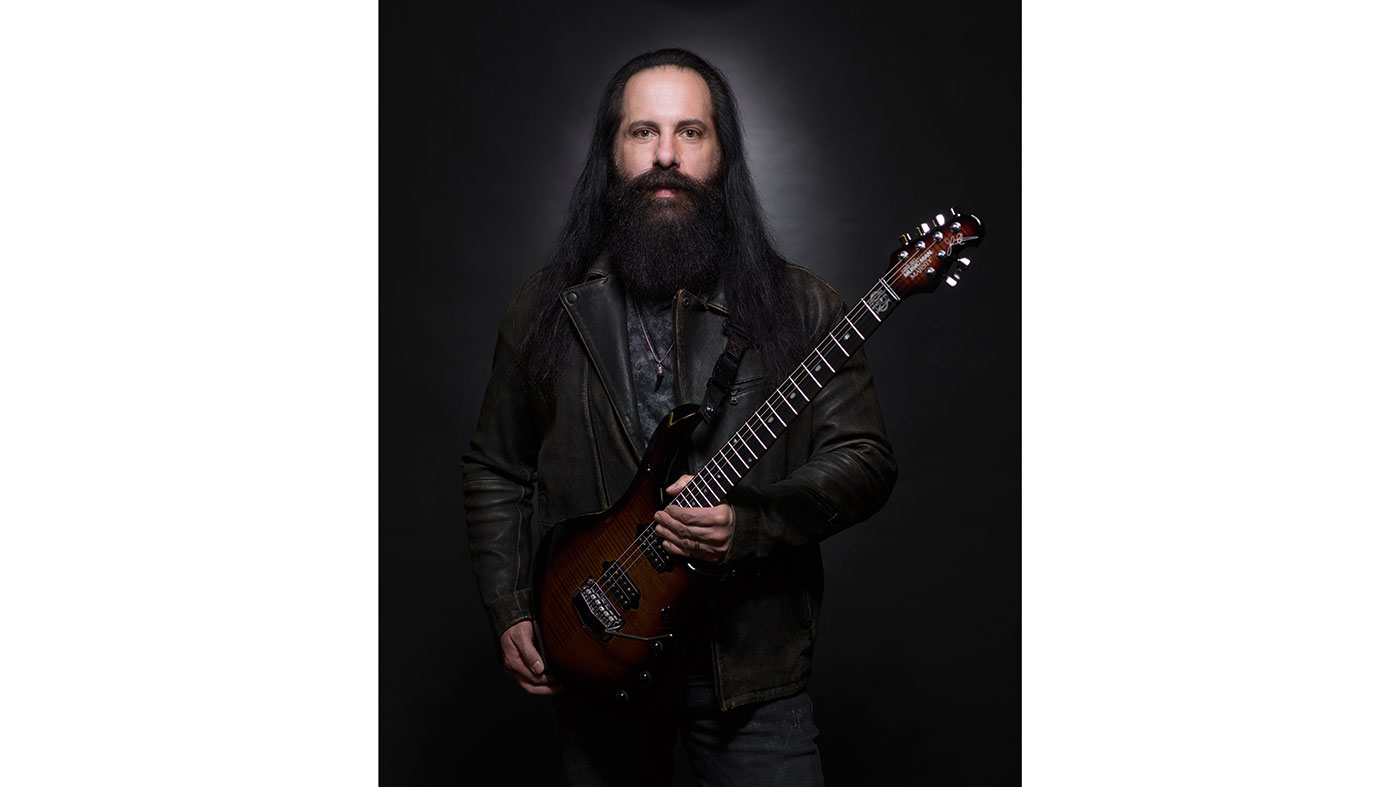John Petrucci: “People don’t want any old noodling thing that they’ll fast-forward; your solos need to give them something that’s part of the composition”
The Dream Theater guitar hero goes in-depth on technique, Distance Over Time and the most difficult song in his repertoire

As a guitarist, Dream Theater founder John Petrucci exists in a class of his own. To mark the release of the band’s 14th opus, he explains more about the formidable techniques that have made his presence known the world over…
“Now definitely feels like an exciting time for progressive metal,” says John Petrucci, grinning from behind his beard while sitting in one of the many rooms in the mazes of Dream Theater’s major label office.
“When we started, that whole scene didn’t exist,” he continues. “We just got together and started writing this way because we liked Iron Maiden and Metallica as well as Rush and Yes, that’s why we ended up putting it all together...”
Three-and-a-half decades since their formation (although the guitarist is too modest to admit it himself) the world of progressive music owes them a debt. They’ve been filling arenas with uncompromising music and attracting a formidable fanbase of musicians, inspiring countless others to create music as rich in classical sophistication as it is in heavy metal thunder.
Throughout the years, their prog-man has remained one of the world’s most admired - the kind of player able to offset mechanical precision with human emotion in remarkable ways that few have ever come close to. Here, he explains the techniques and tones behind the quintet’s tour de force 14th full-length album, Distance Over Time...
One of this album’s major strengths is the odd-metered riffs and the groove they have; what’s the secret to making that combination work so well?
It’s always easier playing with a drummer. If you’re cranked up and stood next to someone behind a kit, you can feel each other
“For me, it’s always easier playing with a drummer. If you’re cranked up and stood next to someone behind a kit, you can feel each other a lot better. You can recognise the nicer grooves a lot quicker. Sometimes you can really get into the weeds if you’re by yourself and working hyper technical things out, maybe programming drums or whatever, and that leaves you a little disconnected from the roots and primal aspect of it. When there’s a drummer right there with you, even if they play something that’s in an odd-time, you can feel how they’re moving based on all the inflections and syncopation.
Want all the hottest music and gear news, reviews, deals, features and more, direct to your inbox? Sign up here.
“For example, the song S2N starts with this riff on the bass that is so typical of John Myung, where he comes in with something that nobody understands. But he doesn’t understand what he’s doing either ha ha! We had to slowly dissect it and learn it together. It even took our drummer Mike Mangini a long time to hear it in a way that made sense. It’s so quirky and in an odd-time, but still there’s something about it that just grooves and swings.”
The solo in that song ends with a lick that moves up chromatically, almost in a Steve Vai way...
“You’re right to mention Steve Vai there… that’s totally out of his book! In that solo, there’s a crescendo fairly early on. So I started thinking about where could I go from there, and realised doing something really outside to create tension was the best place to go. Because what else are you going to do? Play more notes?! There should always be some sort of conclusion or climax to your solos.”

Staccato style
Opening track Untethered Angel has some quick-fire staccato bursts halfway through. For someone approaching that kind of technique, how should they look to develop it tightly and precisely?
“This is all about groove and syncopation. If you stick on a metronome, there’s a steady 4/4 pulse behind it, so slow it down and build up your 16th notes like that. It’s a lot easier to get the co-ordination right first - I’ve always said this throughout my career - and then you slowly build the speed up.
“But feeling it right first is key - you need 33 to know where the notes land in respect to the downbeat. That’s how you get the accent right where it’s meant to be.”
Like many of your leads, it seamlessly switches through major scale modes, harmonic minor, diminished and chromatic ideas. What drives that kind of blending for you?
You need to give them something that’s part of the composition. Your solos should be as interesting as any other part of the song
“I never know if anyone notices all these things - so thank you... I have to relearn what I played for the live shows, by the way! I recorded the Untethered Angel solo and then Jordan put down his piano part around it. He carved out his part to support the harmony I was using, which made me sound really smart - but actually on that one, the chords came after!
“I weave through different scales and we adjust the chords to work. When I listen back to a solo, I always think it needs to stay exciting and contribute to the song in a way that helps the listener. People don’t want just any old noodling thing that they’ll fast-forward; you need to give them something that’s part of the composition.
“Your solos should be as interesting as any other part of the song. It’s not an opportunity to shred… okay, sometimes it is! Look at solos more like a compositional opportunity, like watching a movie. No-one wants a dead-boring scene; it has to push the story forward.”
How much time do you spend mapping out every possible scale you can use over each chord?
“Mapping out what scales you can use on every chord is a great technique, if you want to know more about what the options are, but I tend to approach things more melodically. I have those options somewhere in my subconscious, but instead of making a list, I pull out the melody I want to hear most.”
Fall Into The Light ends with a wide-interval, open-string pull-off motif that feels almost more like keyboards in its sense of phrasing...
“It makes things more interesting melodically when you use intervals like that. You can imply chords that aren’t necessarily there. Instead of the stock traditional root, 3rd and 5th, you can spread your tones apart.
“Everything I play, I always ask myself, ‘Have I heard that before?’ and if the answer is ‘Yes’, I’ll try it another way that still sounds like me in a different way to any solo before. Experimenting with your spread of intervals is a good way to do that.
“The open string also creates some dissonance, especially with half-step stuff going on there, but there’s this pedal tone. That’s a few techniques rolled into one… at the time I was thinking of what the song needed and how I could drive it home!”

Barstool breakout
Barstool Warrior certainly has a lot of sweep picking...
“There’s a lot of that in there. I make things up based on the melody of the song. I’ll notice how I can spread my notes out onto one per string and then sweep through. Look at the notes you are playing and think about how they might work played in different positions on other strings. That’s a big part of my approach; I’m always thinking how else I could play each part.
Try eighth-note sweeps - I’ve seen so many people trip up because they’re used to only going fast
“As for my sweeping, there are two parts. The first is separating the notes you play, which is your left-hand technique. If you are just doing it with your right hand and the left-hand notes are ringing into each other, it will sound more like a chord.
“The second thing, and this is the hard part, is making the notes fall in actual time. When you rake, it’s easy to do it in one motion and hard to go against deliberate time. Try eighth-note sweeps - I’ve seen so many people trip up because they’re used to only going fast… it’s actually a lot harder.”
What advice can you offer players who, having gained a lot of technical proficiency, find it hard to decelerate and play with feel?
“You can approach the guitar like a voice. That’s the best way of looking at it. If you are singing, you can’t keep going a million miles an hour. You can only fit so many syllables in, so think about what you can sing through your guitar.
“Players like David Gilmour and Neal Schon are great at that kind of thing. The solo in Comfortably Numb is so memorable, you can sing along to it. The other part of it is your technique as a guitarist. Once you are in that zone, hanging on notes and doing slow bends, there are so many things that can go wrong. You can bend out of tune - so technique is very important, just like it is when a singer hits flat. That really hurts your ears! So apply the same thinking into your vibrato and bends… that’s when you are exposed.
“If you are playing a very well-known melody live and you hit a note just a half-step from where it should be, it’s so much more noticeable compared to a crazy passage that goes by super-fast. Something like the intro to Another Day from Images And Words needs to be perfect. Believe me, I’ve messed it up before and it’s really no fun. You have to be careful, because playing slower involves a different kind of focus.”

Taming the shred beast
The bluesier passages in Room 137, S2N and At Wit’s End definitely show you know how to tame the shred beast within...
“‘How to tame the shred beast within...’ I really like that, haha! You know, it’s all about variation. When you’re playing in a certain style, with a certain technique, people feel different things. In more complex music, something more bluesy and soulful can really pull the listener in - so you need to know how to switch gears. Don’t just take one road to get to your final destination; change it up as you play and that will always make things so much more interesting.
I was blown away jamming with Joe Satriani every night. His whole approach is based on feel
“The same goes in reverse, for example, if you play mainly blues and then stick in this sick, crazy lick... that’s really going to stand out! Before recording these solos, I’d been on four months of G3, as well as my Guitar Universe camp, jamming with some of the greatest players in the world. I can tell you now, I was pumped up, I was ready!”
What have you learned from all those experiences with other guitar legends?
“Honestly, it’s one thing to listen to someone and then another to actually play with them and interact. I was blown away jamming with Joe Satriani every night. His whole approach is based on feel; he has attitude, melody and technique coming out of this crazy imagination. It seeps into you!
“And then at the camp, I had so many great players like Guthrie Govan, Andy James, Tosin Abasi, Jason Richardson, Al Di Meola… such different players, but they’ve all rubbed off on me somehow. You can’t help it. If you are a good listener and open to learning, then it’s gonna happen.”
If you were taking requests at a clinic, what would be the most punishing song in your repertoire that you could get asked to play?
“There’s one that’s especially hard… The Glass Prison! Jordan (Rudess) was playing this keyboard line that I copied on guitar and I’ve been kicking myself hard ever since because it’s so difficult to play. These arpeggios go by so fast and there are a few different techniques you can use, from alternate picking and hybrid through to sweeps, it’s one of the hardest things to play right there on the spot. I’ve seen footage of people playing it on YouTube… I bow down and am very jealous! It really is quite the challenge.”
There are a lot of harmonies mirrored in Jordan’s keyboards during your rhythm parts, as well as guitar overdubs for the leads. What’s the best way of constructing these adjacent lines?
“Harmonies can sound very typical and boring on songs that use straight harmonies. And, in fact, there’s a lot more you can do if you don’t stick to just one interval. Using only 3rds will sound a certain way, but a combination of 3rds, 4ths and 5ths while also displacing the octaves can make for a really interesting sound.
“Obviously, it all has to fit with the chords, but there are more options out there than a lot of people realise when it comes to harmonies. Remember - a harmony doesn’t have to move either, it can stay on a common tone while the melody changes. That’s another way of looking at them.”
Amit has been writing for titles like Total Guitar, MusicRadar and Guitar World for over a decade and counts Richie Kotzen, Guthrie Govan and Jeff Beck among his primary influences. He's interviewed everyone from Ozzy Osbourne and Lemmy to Slash and Jimmy Page, and once even traded solos with a member of Slayer on a track released internationally. As a session guitarist, he's played alongside members of Judas Priest and Uriah Heep in London ensemble Metalworks, as well as handling lead guitars for legends like Glen Matlock (Sex Pistols, The Faces) and Stu Hamm (Steve Vai, Joe Satriani, G3).



